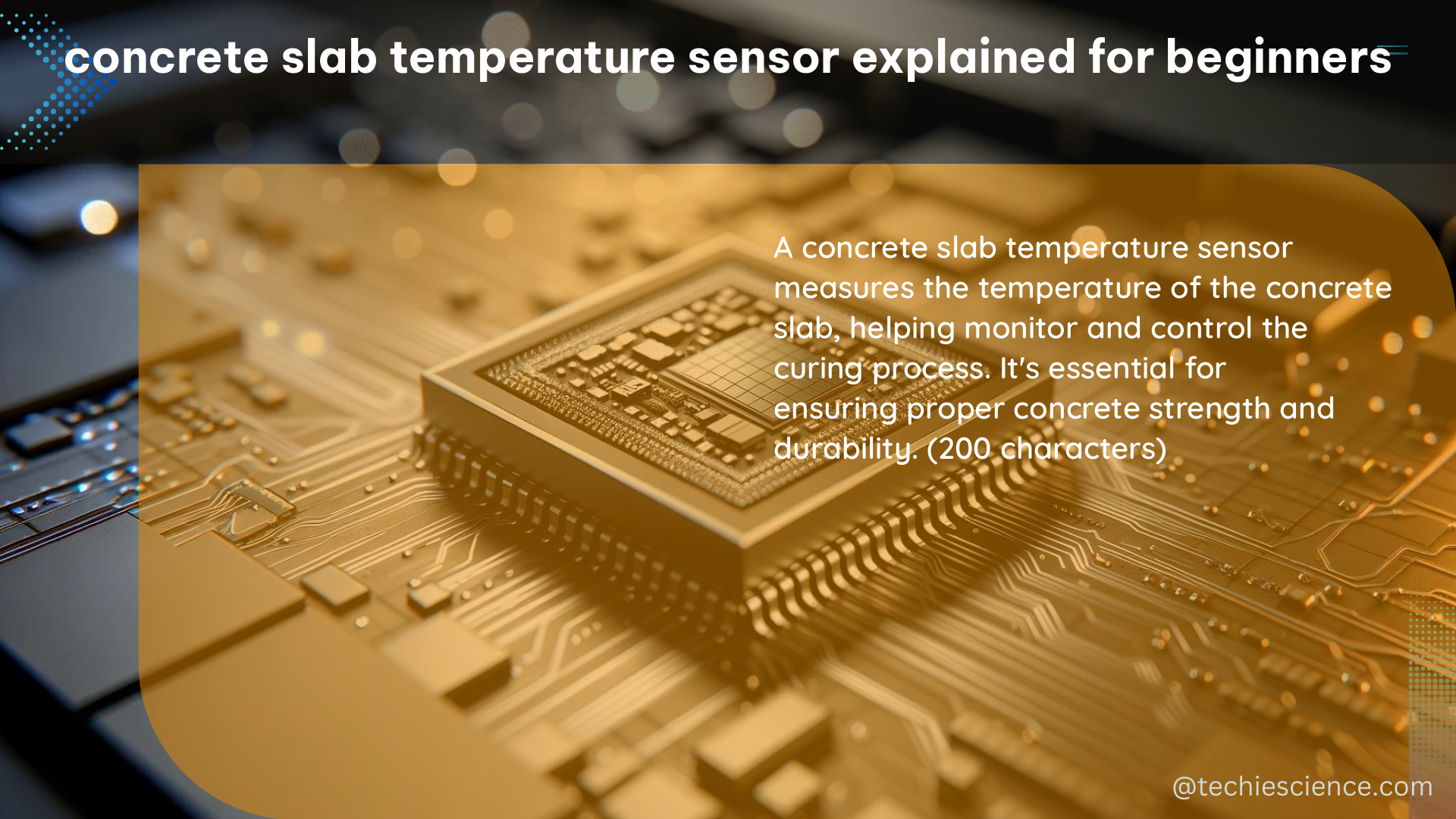A concrete slab temperature sensor is a crucial device used to monitor the temperature of a concrete slab during the curing process, ensuring the structural integrity and sustainability of building and infrastructure projects. This comprehensive guide will provide beginners with a detailed understanding of the technical specifications, installation, and practical applications of concrete slab temperature sensors.
Understanding the Basics of Concrete Slab Temperature Sensors
Concrete slab temperature sensors are designed to measure the temperature of a concrete slab at various depths and locations during the curing process. These sensors typically consist of a probe that is inserted into the concrete during the pouring stage, connected to a data logger or monitoring system that records and displays the temperature readings.
Technical Specifications of Concrete Slab Temperature Sensors
- Measurement Range: Concrete slab temperature sensors typically have a measurement range of -40°C to +200°C, allowing them to accurately monitor the temperature fluctuations during the entire curing process.
- Accuracy: The accuracy of these sensors ranges from ±0.5°C to ±2°C, ensuring precise temperature measurements.
- Response Time: The response time, which is the time it takes for the sensor to respond to a change in temperature, is typically around 1-2 seconds, providing real-time data.
- Probe Length: The probe length can vary from 10 cm to 1 m, depending on the size and thickness of the concrete slab being monitored.
Sensor Placement and Installation
When it comes to DIY installation, concrete slab temperature sensors are relatively easy to set up. The probe is inserted into the concrete at a predetermined depth and location, ensuring that it is placed in a representative area of the slab, away from any heat sources or cold drafts. The sensor is then connected to the data logger or monitoring system, which can be placed in a convenient location for easy access and data retrieval.
Monitoring the Concrete Curing Process

Concrete slab temperature sensors play a crucial role in monitoring the curing process of concrete, which is essential for the structural integrity of the building or infrastructure project.
Real-Time Temperature Monitoring
The sensors provide real-time temperature readings at different depths and locations within the concrete slab. This data can be used to track the progress of the curing process and ensure that the concrete reaches the required strength and curing time.
Optimizing Concrete Mix Design
The temperature data collected by the sensors can also be used to optimize the concrete mix design, reducing the amount of cement required and leading to cost savings and a more sustainable construction process.
Ensuring Structural Integrity
By monitoring the temperature of the concrete slab during the curing process, the sensors help ensure that the concrete reaches the necessary strength and curing time, which is essential for the structural integrity of the building or infrastructure project.
Practical Applications of Concrete Slab Temperature Sensors
Concrete slab temperature sensors have a wide range of practical applications in the construction industry, including:
- Residential and Commercial Construction: These sensors are used to monitor the curing process of concrete slabs in residential and commercial buildings, ensuring the structural stability and longevity of the structures.
- Infrastructure Projects: Concrete slab temperature sensors are crucial for monitoring the curing of concrete used in the construction of bridges, roads, and other infrastructure projects, where the structural integrity of the concrete is of utmost importance.
- Precast Concrete Production: In precast concrete manufacturing, these sensors are used to monitor the curing process of concrete elements, ensuring consistent quality and compliance with industry standards.
- Concrete Research and Development: Concrete slab temperature sensors are used in research and development settings to study the effects of temperature on concrete curing and to develop new concrete mix designs and curing techniques.
Conclusion
Concrete slab temperature sensors are essential tools for ensuring the structural integrity and sustainability of building and infrastructure projects. By providing real-time temperature data, these sensors help optimize the concrete mix design, reduce cement usage, and ensure that the concrete reaches the required strength and curing time. With their technical specifications, easy installation, and wide range of practical applications, concrete slab temperature sensors are a valuable asset for any construction project.
References:
- Micro-Epsilon. (2019). Basics of non-contact temperature measurement. Retrieved from https://www.micro-epsilon.com/fileadmin/download/products/dat–infrared-basics–en-us.pdf
- ResearchGate. (2013). Long-term vibration monitoring of an RC slab: Temperature and humidity effect. Retrieved from https://www.researchgate.net/publication/223949489_Long_term_vibration_monitoring_of_an_RC_slab_Temperature_and_humidity_effect
- Command Center Concrete. (2024). COMMAND Center™ sensors for concrete temperature & maturity. Retrieved from https://www.commandcenterconcrete.com/pricing/command-center-sensor/
- Giatec Scientific. (2021). Concrete Slab Temperature Sensor SmartRock® for Easy Testing. Retrieved from https://www.giatecscientific.com/education/want-to-check-on-that-concrete-slab-you-just-poured-now-theres-a-smartphone-app/
- Missouri University of Science and Technology. (n.d.). Temperature Measurement. Retrieved from https://web.mst.edu/~cottrell/me240/resources/temperature/temperature.pdf

The lambdageeks.com Core SME Team is a group of experienced subject matter experts from diverse scientific and technical fields including Physics, Chemistry, Technology,Electronics & Electrical Engineering, Automotive, Mechanical Engineering. Our team collaborates to create high-quality, well-researched articles on a wide range of science and technology topics for the lambdageeks.com website.
All Our Senior SME are having more than 7 Years of experience in the respective fields . They are either Working Industry Professionals or assocaited With different Universities. Refer Our Authors Page to get to know About our Core SMEs.